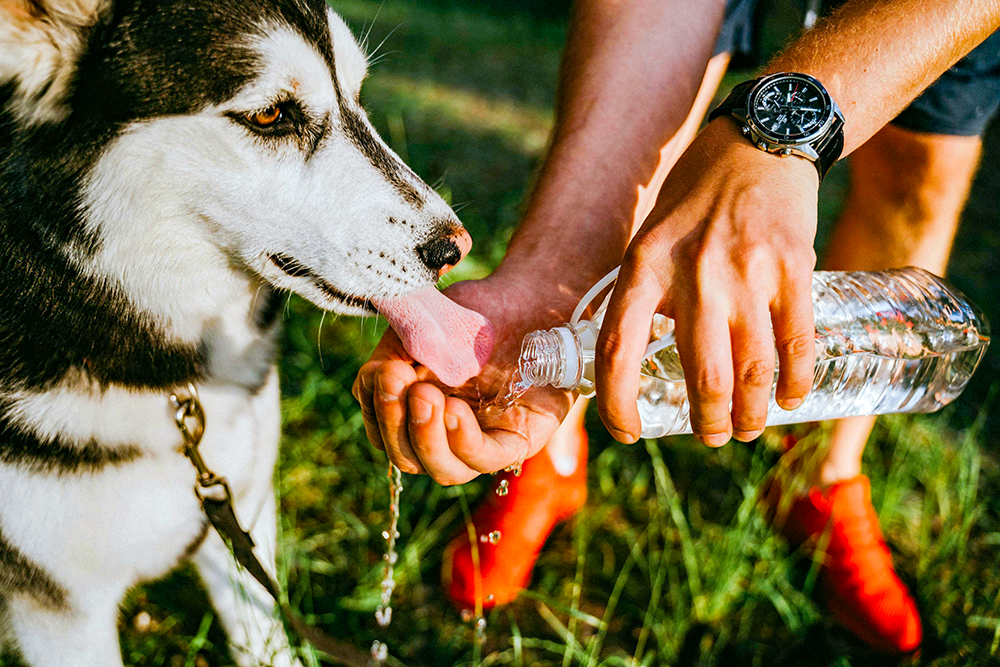Summer is in full swing–bringing long, sunny days, backyard cookouts, and plenty of adventures with your four-legged family members. While we soak up the season, it’s easy to forget that heat and humidity can take a serious toll on our pets, sometimes faster than we expect.
At AcutePet Urgent Care, we often treat pets in distress from heat-related emergencies like dehydration–many of which could have been avoided with a little preparation. Let’s talk about some simple, no-cost steps you can take to help your pets stay safe, cool, and comfortable all summer long.
1. Summer Hydration Hazards: What Every Pet Parent Needs to Know
Dehydration in pets can happen fast, especially during the summer months. Unlike humans, dogs and cats can’t rely on sweating to regulate body temperatures. Instead, they cool themselves by panting or sweating minimally through their paw pads. This makes them far more vulnerable to overheating and rapid fluid loss.
High humidity levels put your furry friends at even greater risk of dehydration. When the air is muggy, their cooling system stops working as well, and heat builds up quickly inside their bodies. If you’re feeling sticky and uncomfortable, chances are your pet is, too–and they don’t have as many ways to cope.
Even a short time outside or in a hot room can put your pet at risk. Here are a few things we always tell pet owners to look for:
Signs of dehydration in pets:
- Excessive panting or drooling
- Lethargy, weakness, or acting disoriented
- Bright red gums or tongue
- Sunken eyes
- Loss of skin elasticity (when you gently pinch the skin, it doesn’t snap back quickly)
- Decreased appetite or vomiting
- Collapse or unresponsiveness (seek immediate veterinary care)
High-risk pets include:
- Senior animals
- Puppies or kittens due to smaller size and higher metabolic rates
- Pets with chronic health conditions like heart disease or diabetes
- Brachycephalic breeds who struggle with breathing (Pugs, Bulldogs, Persians)
If you notice these symptoms, every minute matters. Move your pet to a cool area right away and call us or your veterinarian. At AcutePet, we’re open 7 days a week from 10 AM to 10 PM. You don’t have to wait until Monday morning or struggle to find care. Our clinics are equipped with in-house diagnostic tools and IV therapy to treat dehydration and restore your pet’s hydration levels effectively and comfortably in a calm, outpatient setting.
2. Proactive Prevention: Easy Ways to Keep Your Pet Hydrated
The best way to avoid hydration emergencies is proactive prevention. A few small changes can make a big difference in whether your pet ends up needing emergency care.
Smart Hydration Tips:
- Place multiple water bowls around the home
- Use elevated bowls for senior pets or those with arthritis
- Try a pet fountain—many pets prefer running water (encourages drinking while keeping water fresh and oxygenated)
- Add ice cubes or offer frozen broth-based treats (provides hydration and cooling relief)
- Avoid outdoor activity during peak heat hours and ensure you have access to a travel water bowl, and water, and shade for both of you
- Never leave a pet in a parked car—even briefly
How Much Water Does Your Pet Need?
- Dogs: 1 oz. per pound of body weight daily
- Cats: 3.5 – 4.5 oz. per 5 pounds of body weight
Diet, activity level, and current health can affect hydration needs. Being familiar with your pet’s normal habits will help you monitor your pet’s normal water intake so you can quickly identify changes.
3. When Increased Thirst Signals Something More Serious
While it’s normal for pets to drink more water on hot days or after exercise, if your pet starts guzzling water (or refuses it entirely), it may be a red flag. Excessive thirst—called polydipsia in veterinary terms—often appears alongside serious diseases like diabetes, kidney disease, and hyperthyroidism.
If your pet’s water intake doubles or they seem constantly thirsty, don’t wait it out—get them evaluated. Diabetes in pets can cause intense thirst as their bodies try to flush out excess glucose. Kidney disease often increases thirst as the kidneys struggle to concentrate urine properly. Even infections or certain medications can dramatically alter your pet’s hydration needs.
AcutePet’s experienced veterinarians can quickly assess these symptoms and provide same-day diagnostic testing, helping you get answers so you don’t have to worry.
4. Know When to Seek Immediate Care
Sometimes, no matter how prepared you are, emergencies happen. Trust your instincts—if your pet seems “off” or you’re concerned about their drinking habits or energy levels, it’s always safer to get checked out, and could provide life-saving intervention.
Seek immediate veterinary care if your pet shows:
- Vomiting or diarrhea
- Weakness or collapse
- Extreme panting or drooling
- Confusion or discorientation
- Refusal to drink paired with lethargy
These could signal heat stroke, or severe dehydration, or a more serious medical issue.
At AcutePet, we understand that pet health concerns don’t wait for convenient times. Our passionate veterinarians are trained to quickly assess hydration status and identify underlying causes of thirst changes. With same-day appointments and walk-in care options, you can get the expert care your pet needs without the high cost or long waits of emergency hospitals.
Your Pet’s Health Can’t Wait—And Neither Should You
This summer, take a moment to evaluate your pet’s hydration habits, making improvements to their water access and summer care routine. And when something seems off, you’re never overreacting by seeking professional guidance.
Call or book online today if you have any concerns about your pet’s hydration or health. We’re here when you need us to navigate unexpected health concerns with confidence, ensuring your pet stays healthy and hydrated all summer long.
